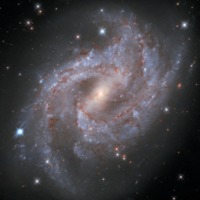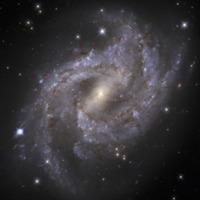NGC 2525
Dublin Core
Title
Subject
Description
Astronomers using NASA's Hubble Space Telescope captured the quick, fading celebrity status of a supernova, the self-detonation of a star. The Hubble snapshots have been assembled into a telling movie of the titanic stellar blast disappearing into oblivion in the spiral galaxy NGC 2525, located 70 million light-years away.
Hubble began observing SN 2018gv in February 2018, after the supernova was first detected by amateur astronomer Koichi Itagaki a few weeks earlier in mid-January. Hubble astronomers were using the supernova as part of a program to precisely measure the expansion rate of the universe—a key value in understanding the physical underpinnings of the cosmos. The supernova serves as a milepost maker to measure galaxy distances, a fundamental value needed for measuring the expansion of space.
The supernova appears as a blazing star located on the galaxy's outer edge in the lower left portion of the frame. It initially outshines the brightest stars in the galaxy before fading out of sight. The time-lapse video consists of observations taken from February 2018 to February 2019.

